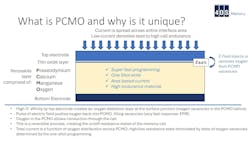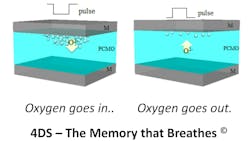What you’ll learn:
- What is PCMO ReRAM?
- Difference between filamentary and PCMO ReRAM.
- Why tunable persistence is important.
The idea of non-volatile, resistive RAM (ReRAM) has been around for a while. Its aim is to change the resistance of a memory cell to encode the usual binary value. Other memory technologies have the same concept, although how long data remains intact and how it’s maintained differs. Static memory (SRAM) requires power as does dynamic RAM (DRAM), although the latter must be periodically refreshed to maintain integrity. Flash memory is another technology that offers non-volatile storage, but it’s slower than SRAM or DRAM.
4DS Memory has added praseodymium calcium manganese oxygen (PCMO) ReRAM to the mix. The basic technology, started in 2007, has resulted in a 20-nm demo chip to highlight the technology (Fig. 1).
PCMO is designed to be fast on the order of DRAM while providing non-volatile storage—sort of. I talked with 4DS Memory’s Chief Strategic Officer, Peter Himes, about PCMO ReRAM (watch the video above).
Types of ReRAM
Before diving into the details, we take a quick look at ReRAM technology in general. There are two major types: filamentary and PCMO ReRAM. Filamentary ReRAM, like that from Crossbar or Weebit Nano, creates or removes nanofilaments from one side of a memory cell to another. 4DS Memory’s PCMO ReRAM moves around oxygen ions to change the cell’s resistivity. In both cases, the cell value is sensed by changes in its resistance (Fig. 2).
Filamentary ReRAM tends to be used for applications like CXL-based memory. Its endurance is on the order of 105 cycles, and it tends to require more power to program a cell compared to PCMO ReRAM. Crossbar’s technology has been used in some interesting applications like physically unclonable functions (PUFs) in addition to long-term storage applications currently dominated by flash memory.
PCMO ReRAM’s endurance is higher (109 cycles), but its persistence ranges from hours to months. The duration, which is configurable, can be adjusted on the fly if needed. The tradeoff is in programming speed, power, and endurance. In a sense, PCMO ReRAM is much like DRAM but with a very long, refresh cycle time. 4DS Memory’s technology is comparable in performance to DRAM with an electrical pulse induced resistance (EPIR) on-shot write response time of 4.7 ns.
Use Cases for PCMO ReRAM
Though many may look at computer memory as just volatile or non-volatile, the memory hierarchy these days is much more complex, especially on servers. It starts with multiple cache levels based on SRAM through DRAM to bulk, non-volatile storage using flash memory or hard-disk drives. The types of applications have been changing as well, from basic servers to cloud systems that incorporate artificial-intelligence/machine-learning (AI/ML) accelerators and GPGPUs.
PCMO ReRAM is actually coming at a time when its use meshes well with emerging applications like massive in-memory databases, AI/ML applications, and sophisticated graphics. The amount of memory employed has grown and much of it has been DRAM. A power loss or reset requires reloading of this information, which can take a good bit of time. Likewise, a lot of this data is relatively static. It may only be needed for minutes or hours.
Replacing DRAM with PCMO ReRAM provides non-volatile storage; refreshing it is more efficient while maintaining system performance. The ability to tailor performance and retention times is an advantage that enables the memory to match the requirements of the application and system implementation. Being able to reconfigure sections based on different requirements offers an interesting option for applications like databases that might change over time.
Where to Get PCMO ReRAM
PCMO ReRAM will not be found in its own chip at this point. 4DS Memory is more interested in licensing its technology but it is working with foundries to make it accessible to chip designers. The addition of PCMO ReRAM is compatible with CMOS processes with easy backend integration.
PCMO ReRAM differs from most other non-volatile solutions, which makes it complementary in the same fashion as complementing DRAM. Where and how 4DS Memory’s solution will be used is still an open question, and perhaps with some enticing answers.


